| Please access the following URL if you want to secure using SSL. All pages in the site will be secure pages. |
https://secure02.blue.shared-server.net/www.fish-food.co.jp/message english 12.2021.html |
Welcome to FISH FOOD TIMES
Dec. 2021 issue No.216


Yellow drum dishes
Drum family fish
Since yellow drums are often caught in the summer, it is often said that the season is in the summer, but in fact, the fat gets on in the winter and it becomes delicious. Let's take up this yellow drum in this month's issue. The white croaker of the same family Sciaenidae, whose appearance is very similar to the yellow drum, was described in the October 2017 issue No.166, so a similar article may appear. But they are indistinguishably similar, so I'm aware of that, and note the difference.
The image below is the yellow drum of order; Perciformes, suborde; Percoidei, family; Sciaenidae, genus; Nibea.

The name of Nibe is also used as a regional name in Japan, and when Kiguchi enters there, it becomes confusing how to distinguish Koichi and Shiroguchi, also known as Kingchi.
Therefore, the following image was written at the time of the explanation of white croaker, but since it is easy to understand as a way of distinguishing by comparing the images, I decided to post the same one again for understanding in this month's issue. The following images were all taken by the author, and although the places and times when they were taken were different, the sizes were almost balanced.
How to distinguish the family of white croaker (family Sciaenidae) |
|---|
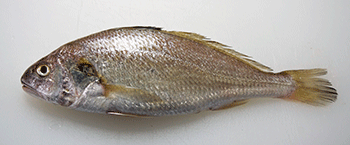 |
White croaker family Sciaenidae, genus PennahiaThe whole is silver white and somewhat slender, tail fin protruding triangle. There is a black spot behind gills lid. |
 |
Yellow croaker family Sciaenidae, genus LarimichthysThe body color is silver white with yellowish color, the abdomen is slightly yellower than the back. Their eyes are close to the tip of the upper jaw, they are big, the origin of the tail fin is thin. |
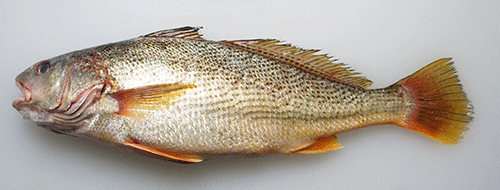 |
Yellow drum family Sciaenidae, genus NibeaIt is yellowish over the whole, black spots below the side line lined up in lines, and the one above it is disturbed. The original part of each fin except for dorsal fin is yellow. |
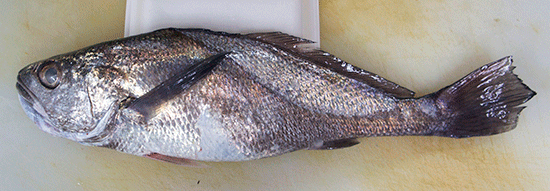 |
Blackmouth croaker family Sciaenidae, genus Atrobucca nibeaPectoral fin is long and reaches behind the first dorsal fin and has a black color overall. |
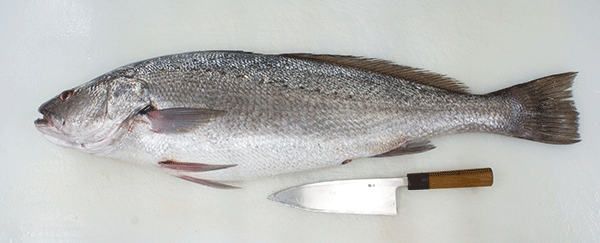 |
Japanese croaker family Sciaenidae, genus Argyrosomus japonicusThe head is small, the length of the pectoral fin does not reach the rear end of the first dorsal fin. The end of tail fin has a little out of the center. |
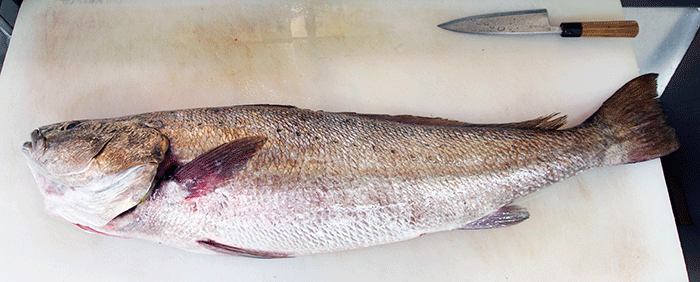 |
Brown croaker family Sciaenidae, genus MiichthysAlong the dorsal fin on the side line, there is an obliquely ordered brown spotle (small black spot column) followed. |
Fish air bladders and vocal muscles
As many as 270 species of Drum family fish have been identified, most of which live in continental coastal waters. They have common features such as having large otoliths and using air bladders to make a cry.
Even fisheries people who often cook Drum family fish are unlikely to see otoliths that do not lead to business, but air bladders are an organ that you will definitely see when you cook.
| Removal of air bladders |
|---|
 |
| It exists so as to cling to the backbone. |
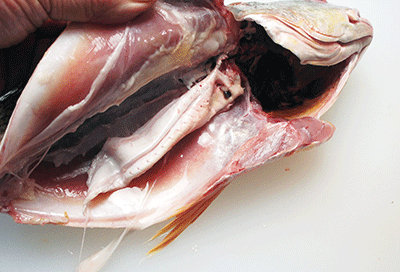 |
| If you remove it with your finger, it will not be scratched easily. |
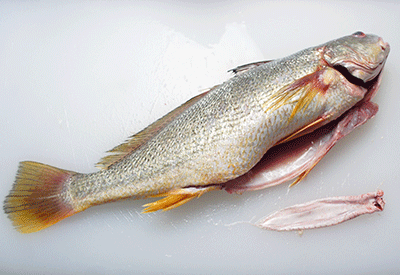 |
| The state where the air bladders are removed. |
Drum family fish, including the Yellow drum, can quiver and squeal this air bladders. Many of the typical Drum family fish, such as the White croaker, Yellow croaker, Yellow drum, and Blackmouth croaker, are named "guchi" because the sound sounds like they are complaining. The cry of this fish is limited to the time of a flood tide when spawning takes place, and seems to be a sound for recognizing each other's existence. Incidentally, it used to be used as a contraceptive in the past.
Next to the air bladders, there are red muscles called vocal muscles on both sides in the image below, and the air bladders resonate by shaking them, which becomes a cry (vibration sound).
| Removal of vocal muscles |
|---|
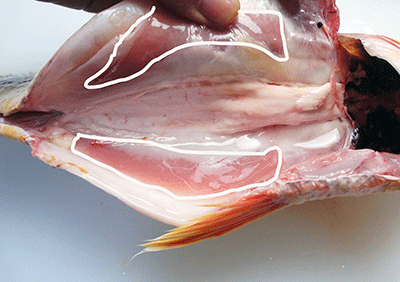 |
| The part surrounded by the white line is vocal muscles |
 |
| When peeling vocal muscles from the half body with two pieces disassembling with your fingers. |
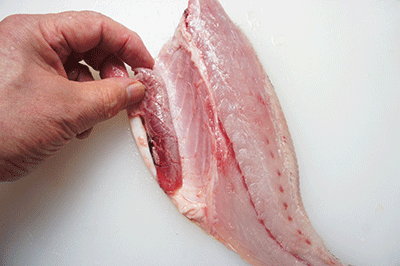 |
| When peeling vocal muscles from the half body without central bone with fingers. |
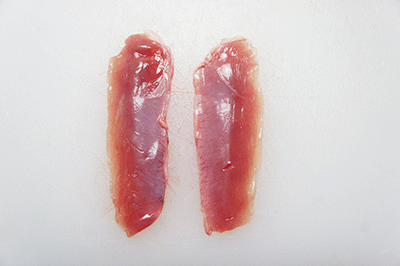 |
| Two vocal muscles removed |
Cooking of air bladders and vocal muscles
If the air bladders and vocal muscles, which clearly show the characteristics of the fish in the Drum family, could be sold as products, it would be as follows, but I have never seen such products in the fish department.
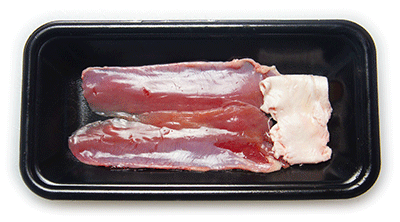
Even if it doesn't sell as a product, it's a waste to dispose of it as unnecessary residue. Anyone can boil down air bladders to make a natural glue, so this is one way to keep it. But unfortunately it's a waste unless you have to spend your time and effort, so the average person wouldn't do that.
On the other hand, considering how to utilize vocal muscles, I think that I have to eat it, so I cooked it with air bladders to eat it.
| Cooking of air bladders and vocal muscles | |
|---|---|
 |
|
| Season with soy sauce and mirin. | |
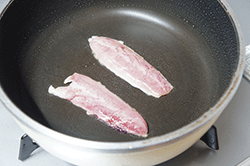 |
 |
| Place in an oiled frying pan. | |
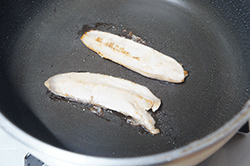 |
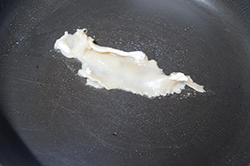 |
| Bake lightly so that it does not burn. | |
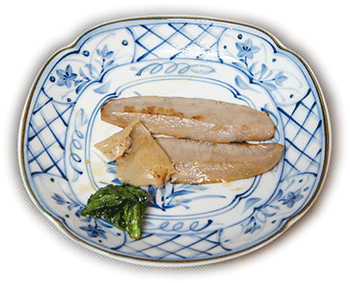 |
|
| Completed sauteed dishes using air bladders and vocal muscles | |
As a result of eating this dish, when the taste is evaluated, air bladders do not have the strong elasticity of the stomach and have a surprisingly soft texture. And the vocal muscles are the masses of the muscles themselves, and I felt that the expression "like fillet" that was used when writing White croaker was correct.
This is because fillet is a long and narrow muscle that has two on the left and right sides of the internal organs, and the official muscle name is called "iliopsoas muscle", which is a muscle that has the role of turning the thigh outward and has few connective tissues, also, there is almost no fat. In other words, the vocal muscles of the Drum family fish are in a similar place, and since they are muscles that have the function of moving the air bladders, I think they can be described as "fish tenderloin". It may seem like a crazy suggestion, but why not sell it as a "rare part fish tenderloin"?
Yellow drum dishes
Let's also mention fish meat other than the internal organs, which is the original protagonist. For example, yellow drum boiled fish wants to cook in the following process.
| Yellow drum fillet and boiled fish process | |
|---|---|
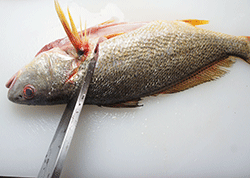 |
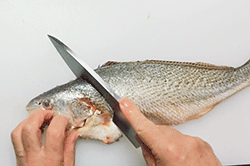 |
| 1,Make a cut to the top of the central bone. | 7,Cut leaving a lot of meat on the head. |
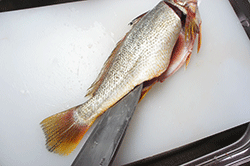 |
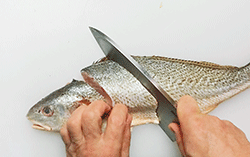 |
| 2,With the fish's head still attached, cut open on the anal fin. | 8,Cut so that the width of the fillet is even. |
 |
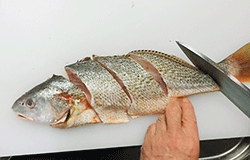 |
| 3,Cut open the top of the dorsal fin to the point where there is a cut. | 9,Cut with a balance of 4 equal parts including the head. |
 |
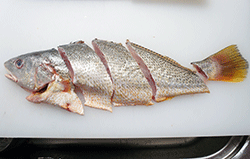 |
| 4,Cut the cutting edge into the center of the head. | 10,Balance in 4 equal parts, excluding the tail. |
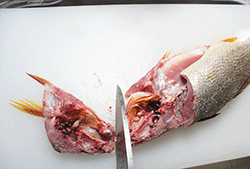 |
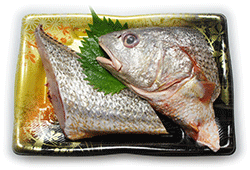 |
| 5,Cut open the head in half. | A little cheaper price setting by combining the head and tail |
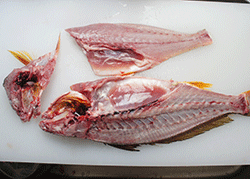 |
 |
| 6,Make two pieces disassembling with the head attached to the upper body. | High selling price setting by combining only good-looking fillets |
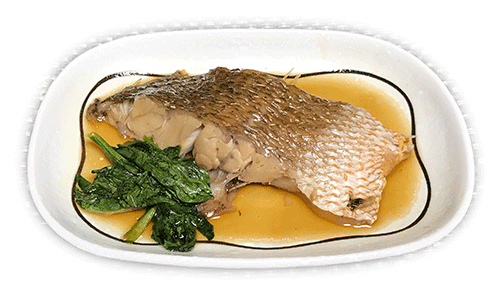 |
|
| Boiled dish of Yellow drum | |
I boiled it with a half body with bones, so when I made sashimi and sushi with the remaining half body without bones, it became as follows.
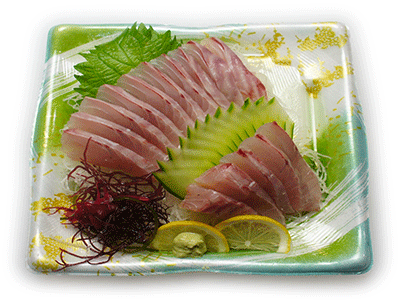

fish tenderloin
By the way, I would like to summarize this month's issue as well. In the olden days, Drum family fish such as White croaker and Yellow croaker, including Yellow drum, which is the main character of this month's issue, could be seen anytime and anywhere as a typical popular fish. However, nowadays, it is rare that the fish are sold at the fish counter.
Until the 1960s, Japan had the west bottom trawling fishery ships catching large quantities of Drum family fish in the East China Sea and the Yellow Sea and bringing them to Japan. However, as the fishing environment surrounding Japan changed drastically, the west bottom trawling fishery declined, and at the same time, the Drum family fish disappeared from the fish counter.
Please refer to the October 2017 issue No.166 for details on the factors behind such environmental changes. In the old days, Drum family fish was often boiled or fried as a popular side dish. However, it is becoming more and more rare and is now treated as being used for sashimi and sushi.
In this month's issue, I was planning to make the Japanese croaker for sashimi the main character. Unlike the White croaker, which is mostly treated as a side dish in Fukuoka, the Yellow drum, which is often treated specially for sashimi, is also called the Japanese croaker in Fukuoka. For that reason, in this month's issue, I was thinking of writing Yellow drum as a Japanese croaker. However, from the author's point of view, I decided that the local name could not be used.
In the past, yellow drum air bladders were also used as a raw material for adhesives called glue, but nowadays Yellow drums are no longer seen as a raw material. And Yellow drum vocal muscles weren't looked at in the past, but what about now? From the point of view of effective use of resources, it is possible to sell it as a rare "fish tenderloin" instead of throwing it away as unnecessary residue.
If you know the fact that the tuna Toro was also abandoned in the past, I suspect that the vocal muscles will look different. I wonder if any of the readers will embody my ideas ...
| Please access the following URL if you want to secure using SSL. All pages in the site will be secure pages. |
https://secure02.blue.shared-server.net/www.fish-food.co.jp/message english 12.2021.html |
An opinion and the communication are to iinfo@fish food times
Date of updating 1 Dec. 2021
